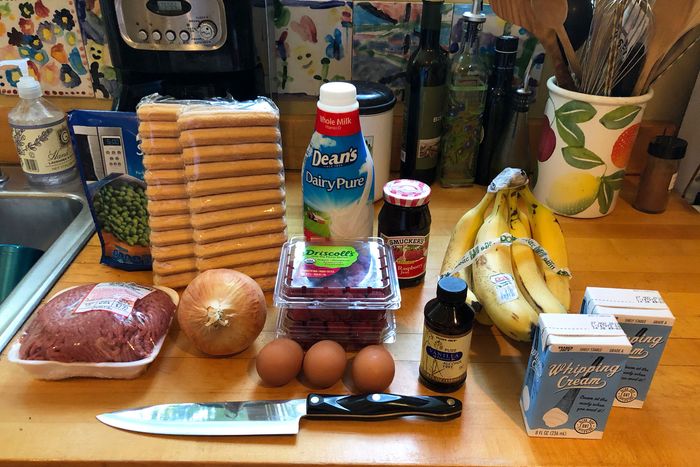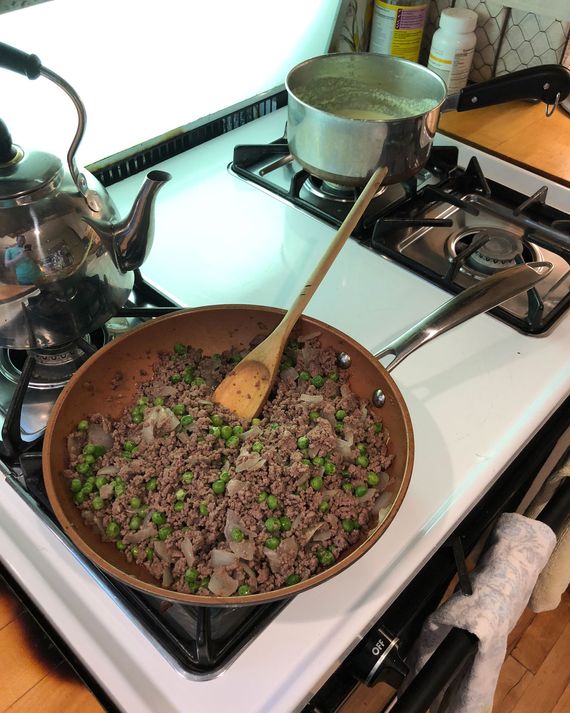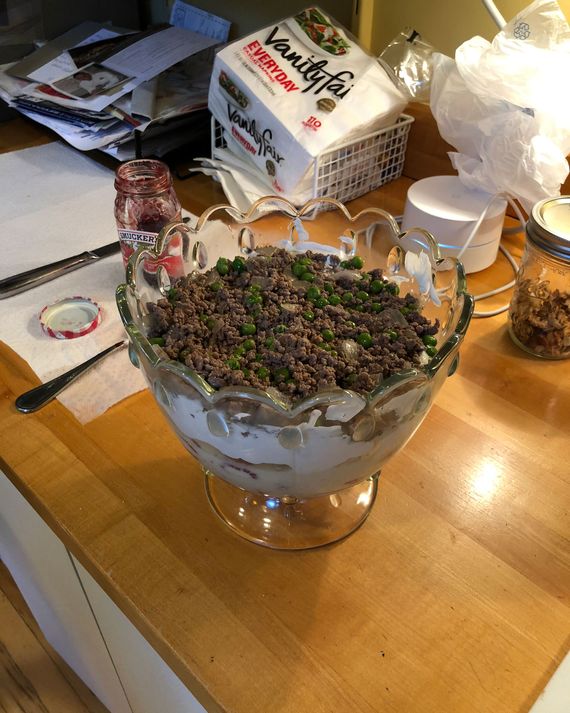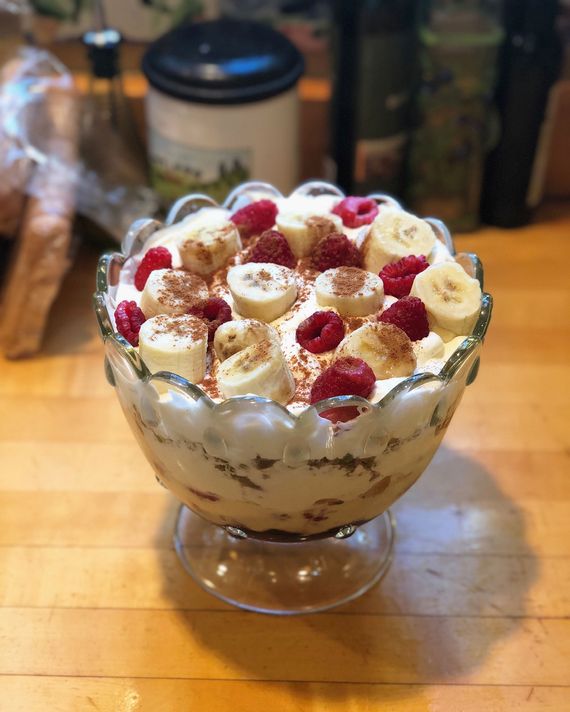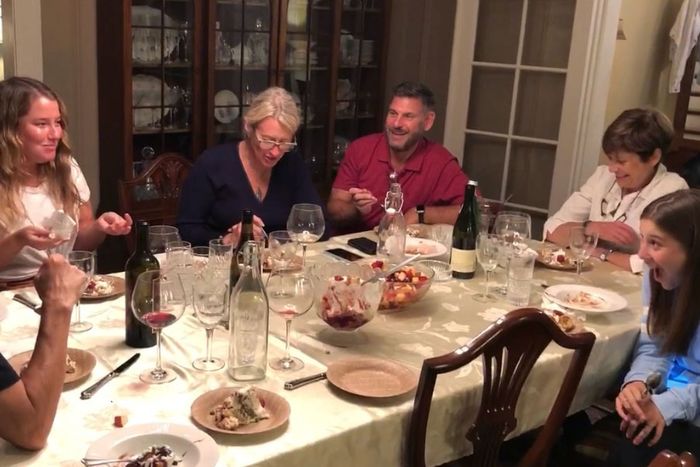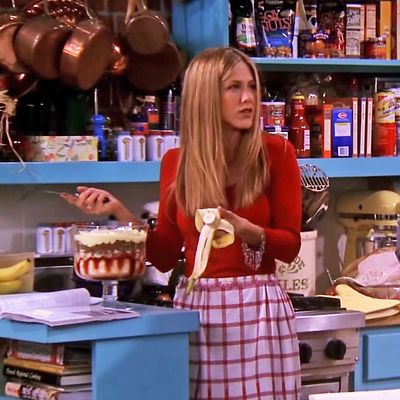
Now is the winter of our Friends content. The show turns 25 this month, and because of the strange significance that our culture has attached to multiples of five, the internet has spent the past few weeks rehashing the series: debating whether Friends is Actually Bad, standing by while Meghan Trainor inexplicably rerecords the theme song, listing “ways to celebrate” the show’s legacy.
When my editor asked us if we had any ideas about how to cover Friends’ anniversary, I was briefly reminded of the chaotic meaninglessness of the universe. Everything about Friends had already been said, and would be said again, perhaps in five more years, then again five more years after that. What did I, a woman named Rachel who has never once escaped her own wedding, have to add to the Möbius strip of the Friends discourse?
Suddenly, I knew. It hit me like a couch tumbling down a flight of narrow stairs. I would make Rachel’s fucked-up English trifle and force-feed it to the people I loved. Why, you ask? The better question: Why not? Had it been done before, you ask? Absolutely, perhaps thousands of times. So why would I do it again? Perhaps I wanted to discover if there was an inherent meaning in the act of repetition. Perhaps I wanted to know if I, an abysmal chef whose profound culinary failures are well documented, could succeed at cooking a meal if it was supposed to be bad on purpose. Perhaps, as someone who made biscuits literally one time and drew the ire of the entire biscuit internet, I thought it was important that I ingratiate myself to another corner of the internet: the poorly made trifle internet. Perhaps I wanted to know if my family loved me enough to eat whipped cream with meat in it.
In the Friends episode in question, entitled “The One Where Ross Got High,” Monica nervously charges Rachel with the task of making dessert for Thanksgiving dinner. Rachel, a flighty bitch like me who cannot follow a recipe for more than three minutes without becoming distracted by the pointless minutiae of her life, carefully prepares a traditional English trifle in an effort to prove to her friends and herself that she does not suck at everything.
Rachel nearly succeeds, but ultimately, she is felled by a mysterious incident wherein the pages of her cookbook become glued together. Unwittingly, she mixes up the recipes for an English trifle and a shepherd’s pie. Her friends, who do not want to discourage her fledgling culinary self-expression, eat it anyway in a beautiful articulation of platonic love.
I decided that, for my own version of Rachel’s trifle, I would not follow an internet-derived recipe, but rather exclusively follow her verbal instructions: “It’s a trifle. It’s got all of these layers. First there’s a layer of ladyfingers, then a layer of jam, then custard, which I made from scratch, then raspberries, more ladyfingers, then beef sauteed with peas and onions, then a little more custard, and then bananas, and then I just put some whipped cream on top!” I did, however, have to find an internet recipe for “custard from scratch,” so I looked for the simplest one and found this version at The Kitchn.
Because I was going home to Chicago for a funeral around the time this assignment was due, I decided I would further traumatize my family by cooking this trifle immediately after said funeral and forcing them to eat it. Because they have spent three decades reluctantly acquiescing to these sorts of deranged ideas, they agreed with no further questions; the only objection came from my dad, who didn’t believe I would be capable of making bespoke custard. “I’ve got news for you: You’re not going to make custard from scratch,” he said. But I was determined to prove him wrong, especially in the face of death.
The night before the funeral, we stopped at my parents’ best friends’ house for a drink, which turned into 12 drinks and a rousing discussion about the afterlife. Several glasses of wine in, I briefly mentioned the recipe I’d be attempting the next day, and Donna, a delightful Italian woman whose home is a treasure trove of carbohydrates, reached into a cabinet and handed me a classic trifle bowl, approximately 50 lady fingers, and two containers of whipping cream. Stunned, I insisted she come over the next day to taste the meaty fruits of my labor. The next day, after the funeral, I headed to the suburban grocery store and purchased the rest of the ingredients.
Back in my family’s ancestral suburban home, I began whipping up the custard. My boyfriend left the kitchen immediately, frightened. I fucked up the custard just as quickly. The recipe called for three egg yolks and whole milk, heated separately and combined at the last possible minute so that the eggs didn’t overcook. Distracted by the complex mechanics of the human lifecycle — and the whipped cream containers, which claimed to require scissors but did not naturally lend themselves to a scissor excision — I combined the milk and eggs right away and found myself staring plaintively at a yellow glop that would not thicken. I decided to let it simmer for awhile in hopes that it would find its way to its true form.
Next, I prepared the beef. I chopped an onion haphazardly, tossed it into a sizzling pan of olive oil, screamed at the scalding hot spray that resulted, calmed myself down, then threw a shit ton of ground beef on top of it all. As I mushed the beef around with a giant spoon, humming the Star is Born soundtrack to myself, my dad, a consummate chef who has been known to spend eight hours making a single pot of spaghetti sauce, stopped by. He gently placed his hands on both sides of his face in an expression of bone-deep horror and disgust.
“This is not how you cook ground beef,” he said, taking the spoon out of my hands and breaking the beef into small chunks with a pair of forks. He surveyed the rest of the scene before him: the non-custard burbling and distended, the half-empty container of jelly, the scattered bag of frozen peas. “I have to call the EPA to make sure that this won’t harm the environment when we throw it away,” he said.
The beef taken care of, I moved on to the whipping cream. I poured both containers into a bowl, grabbed the same whisk I’d been using for the custard, and began to churn. I felt like a competent, hearty woman of the olden days, happily waiting for my 14 children to return from a hunting trip with their father and present me with the pelt of a beautiful, old fox who was ready to die that I would wrap around my head and wear to the market. My dad came back and stared at me. “This is going to take 60 years,” he said, and handed me an electric mixer. “A troubling regret in my life is that I failed to pass this skill set onto you.”
Using the mixer turned out to be a meditative experience. I found myself getting lost in the circles of whipped cream, wondering again whether I was a Monica or a Rachel. I love to clean and force all of my friends to come over to my house all of the time — a classic Monica — but I am also deeply incompetent at almost everything, which is a hallmark of Rachel’s character. If I couldn’t figure out which Friends character I was after 20-plus years of pondering it, did that mean I was doomed to a life of slippery self-awareness? Or was the idea that each person could be slotted frictionlessly into a fictional character … hold that thought. My dad, who was struggling to make a normal dinner around the wasteland of my trifle ingredients, again interrupted my reverie. “I feel like one of the observers at the Los Alamos Nuclear Laboratory,” he mused. “You put on protective clothing and stand a few miles away, underground, on the off chance that things go badly. And when they do, you don’t die right away. You do die, though. But it will be some time before you die.”
Finally, it was time to combine all of the layers. I checked the custard again. It was half solid, which seemed acceptable; weren’t we all, at any given time, merely half solid? I carefully scooped the jam on top of the first layer of ladyfingers, then poured the custard on top of both. It seeped gently into the corners of the trifle pan. I piled a bunch of raspberries and ladyfingers on top of each other, then dumped the entire pan of beef sauteed with peas and onions onto everything. I poured in more custard, obscuring the beef, then added some bananas and topped it all off with whipped cream. I felt like the beloved child of Julia Child and Jackson Pollock.
“You’re a balabusta,” said my dad, who had now been waiting 90 minutes to use his own burners to make dinner for his family. “You look so serene.” My boyfriend returned from his self-imposed exile and suggested I top the whipped cream with additional bananas and raspberries. I did, and it looked gorgeous and extremely professional. The three of us stared proudly at my creation, forgetting for the moment that there was ground beef inside of it.
Later that night, after a delicious meal of salmon and spaghetti, I presented the trifle to my family, along with Donna and her husband Dan, both of whom were not bound by contract of blood to taste my toxic dessert and whose motives remain therefore unknown. “Do we actually have to do this?” asked my 16-year-old sister, who was born into a post-Friends world and therefore is not as easily persuaded into doing self-destructive things for fun. My mom wordlessly handed me a pile of paper plates that read “Merry Christmas,” and I scooped out eight servings of beef trifle.
I went first, making sure to get a spoonful of each layer into my mouth. To my sophisticated palate, it tasted … good? Sort of like Thanksgiving itself: sweet, salty, rife with controversy and destruction. “I can’t believe you just fully did that,” said my sister. My family members stared at each other, sending silent messages of support. I implored everyone to follow my lead, and one by one, they bravely dipped their spoons into the meaty whipped cream.
Donna was the first to speak. “I feel like this is good?” she said. “What is this sauce? Cranberry sauce?” She dipped her spoon back into the trifle, smiling. My sister looked at both of us, open-mouthed. “You guys are sociopaths,” she said.
My dad went next. “This dish is so bad in so many ways,” he said, after three silent minutes in which he held his head in his hands. “I am only eating it out of respect for you.” Dan was a bit gentler: “I want to say … it’s not horrible.”
My boyfriend brilliantly managed to avoid commentary because he offered to film the entire exchange. My mom, who had at this point made 14 different faces while looking at her plate, pushed a chunk of meat out of the way of her custard. “If I had not eaten in several days, I would devour this,” she said. “But right now … it’s not doing it for me.”
My sister stared at us all like we were out of our minds. “It’s awful,” she said. “Rachel. Look at this. Look at this!”
I ate my entire plate.
Later, I felt extremely ill, but also like I had learned something important about life. Life, I decided, was like an English beef trifle. Some days are salty, some days are sweet. Some days are salty and sweet! (To paraphrase my high-school rabbi.) Some days are whipped cream, and some days are beef with whipped cream. Some days are peas, and some days are peas encased in liquid custard. But if you have the right people around you, they will eat those peas with you, even if they really don’t want to and you aren’t offering them financial compensation. And later, when you all feel disgusting, you will connect on that point as well.
So: Why did I make Rachel’s fucked up trifle? Why make anything? Why love anything? What price, dignity? What custard, beef?



